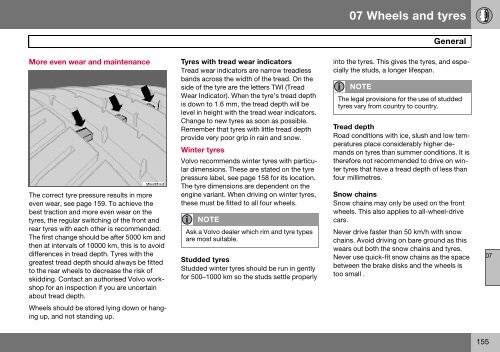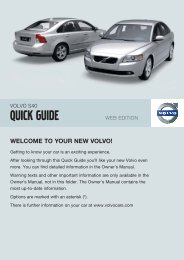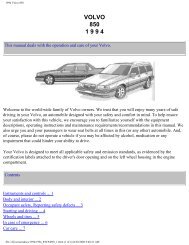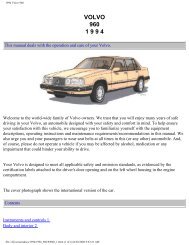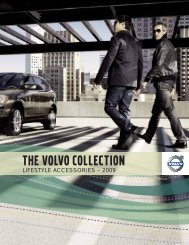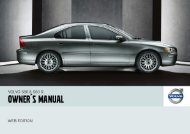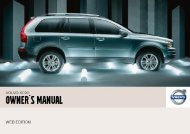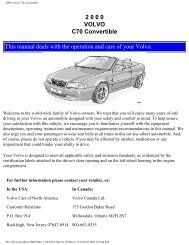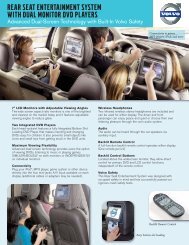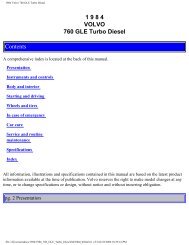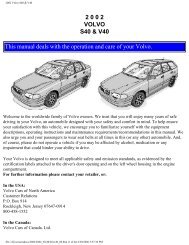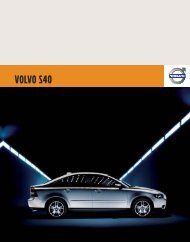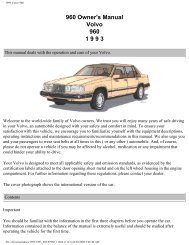V50 w646.book - ESD - Volvo
V50 w646.book - ESD - Volvo
V50 w646.book - ESD - Volvo
Create successful ePaper yourself
Turn your PDF publications into a flip-book with our unique Google optimized e-Paper software.
07 Wheels and tyres<br />
General<br />
More even wear and maintenance<br />
The correct tyre pressure results in more<br />
even wear, see page 159. To achieve the<br />
best traction and more even wear on the<br />
tyres, the regular switching of the front and<br />
rear tyres with each other is recommended.<br />
The first change should be after 5000 km and<br />
then at intervals of 10000 km, this is to avoid<br />
differences in tread depth. Tyres with the<br />
greatest tread depth should always be fitted<br />
to the rear wheels to decrease the risk of<br />
skidding. Contact an authorised <strong>Volvo</strong> workshop<br />
for an inspection if you are uncertain<br />
about tread depth.<br />
Wheels should be stored lying down or hanging<br />
up, and not standing up.<br />
Tyres with tread wear indicators<br />
Tread wear indicators are narrow treadless<br />
bands across the width of the tread. On the<br />
side of the tyre are the letters TWI (Tread<br />
Wear Indicator). When the tyre’s tread depth<br />
is down to 1.6 mm, the tread depth will be<br />
level in height with the tread wear indicators.<br />
Change to new tyres as soon as possible.<br />
Remember that tyres with little tread depth<br />
provide very poor grip in rain and snow.<br />
Winter tyres<br />
<strong>Volvo</strong> recommends winter tyres with particular<br />
dimensions. These are stated on the tyre<br />
pressure label, see page 158 for its location.<br />
The tyre dimensions are dependent on the<br />
engine variant. When driving on winter tyres,<br />
these must be fitted to all four wheels.<br />
NOTE<br />
Ask a <strong>Volvo</strong> dealer which rim and tyre types<br />
are most suitable.<br />
Studded tyres<br />
Studded winter tyres should be run in gently<br />
for 500–1000 km so the studs settle properly<br />
into the tyres. This gives the tyres, and especially<br />
the studs, a longer lifespan.<br />
NOTE<br />
The legal provisions for the use of studded<br />
tyres vary from country to country.<br />
Tread depth<br />
Road conditions with ice, slush and low temperatures<br />
place considerably higher demands<br />
on tyres than summer conditions. It is<br />
therefore not recommended to drive on winter<br />
tyres that have a tread depth of less than<br />
four millimetres.<br />
Snow chains<br />
Snow chains may only be used on the front<br />
wheels. This also applies to all-wheel-drive<br />
cars.<br />
Never drive faster than 50 km/h with snow<br />
chains. Avoid driving on bare ground as this<br />
wears out both the snow chains and tyres.<br />
Never use quick-fit snow chains as the space<br />
between the brake disks and the wheels is<br />
too small .<br />
07<br />
155


